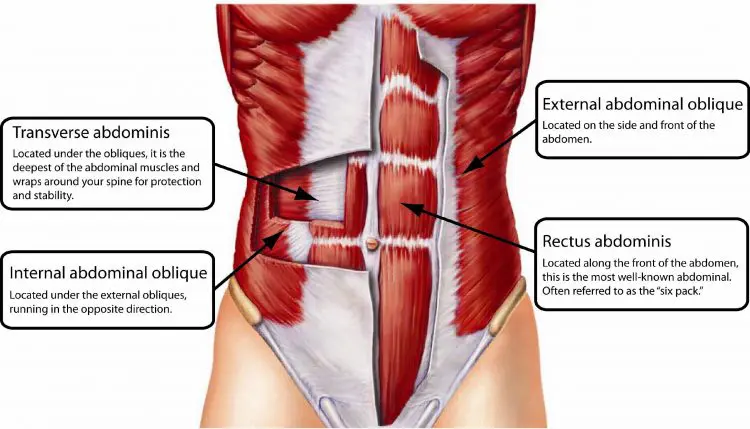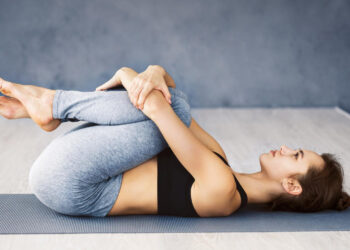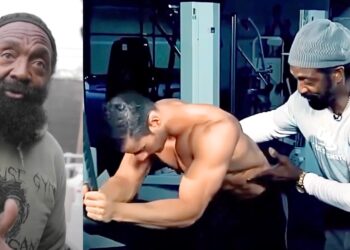Ask most people to name an abs exercise, and they’ll probably say crunches. This response makes a certain amount of sense, given how well crunches target the rectus abdominis, also known as your six-pack muscle.
However, while crunches hit your abs with laser-like precision, they may not be the best way to develop the midsection of your dreams.
For starters, as your fitness and experience level improve, you’ll probably need to perform dozens, if not hundreds, of crunches to fatigue your abs. This can add up to a lot of wasted time – time you’d probably prefer to spend training your arms, right?!
Next, consider the functionality of crunches. Yes, they work your rectus abdominis, but besides sitting up in bed in the morning, how often do you use your abs this way?
Your abs are part of your core, the collective name for the muscles that encircle your waist and support your spine. Training and developing them in isolation makes very little sense, especially if you want to improve athletic or functional performance.
Finally, some fitness experts believe doing lots of crunches causes wear and tear to your lumbar spine and intervertebral discs. While the jury is still out on this touchy topic, it’s safe to say there are plenty of less risky ways to develop your abs (1).
Level Up Your Fitness: Join our 💪 strong community in Fitness Volt Newsletter. Get daily inspiration, expert-backed workouts, nutrition tips, the latest in strength sports, and the support you need to reach your goals. Subscribe for free!
I’m a veteran personal trainer, and I still occasionally prescribe crunches to my army of clients. However, more often, I favor standing, weighted abs exercises. In my experience, these movements are more comfortable, effective, and usually safer, too.
In this article, I share a tried-and-tested ten-minute standing core workout to sculpt your abs and improve your posture.
Core Anatomy Basics
You don’t need a degree in anatomy to train your core effectively. However, a little anatomical knowledge can help you make better choices about which exercises to do. With that in mind, the main muscles that make up your core are:

Rectus abdominis – located on the front of your abdomen, this large, flat muscle is divided into sections, which give it that famous six-pack appearance. However, you’ll need to be pretty lean for this profile to be visible. The rectus abdominis has three main functions:
- Flexion of the spine
- Lateral flexion of the spine
- Spinal stability (anti-extension)
Obliques – located to the side of your rectus abdominis, the obliques are essentially your waist muscles. Like your abs, you need to be lean for these muscles to be visible, but they essentially “frame” your six-pack. The functions of the obliques are:
- Rotation of the spine
- Lateral flexion of the spine
Transverse abdominis – while you can’t see this important muscle, you will definitely feel it working during your core workout. Encircling your abdominal contents like a weightlifting belt, this muscle contracts inward to stabilize your spine. Its function is:
- Compression of the abdominal contents to increase intra-abdominal pressure
Erector spinae – running up either side of your spine in two columns, the erector spinae is actually three overlapping muscles: the iliocostalis, longissimus, and spinalis. Including these muscles in your core workout will help improve your posture and prevent muscle imbalances. The functions of the erector spinae are:
- Extension of the spine
- Lateral flexion of the spine
- Spinal stability (anti-flexion)
The 10-Minute Core Workout That’s Better Than Crunches
Don’t waste your precious time on set after set of high-rep crunches. Instead, get the midsection of your dreams in a fraction of the time by doing this circuit workout 2-3 times per week. Combined with an appropriate diet, you’ll soon be sporting washboard abs and a super-tight waist.
But, before you begin, make sure you prepare your body with an appropriate warm-up. Start with 5-10 minutes of easy cardio followed by dynamic mobility and flexibility exercises for your hips, knees, shoulders, and lower back. Alternatively, add this core workout to the end of your usual training session when you’ll already be warmed up.
Do two laps of the following circuit. Adjust your weights to match your current fitness level. The last 1-3 reps of each exercise should be challenging, but you should be able to maintain good form throughout.
| Exercise | Reps | Rest | |
| 1 | Standing cable crunch | 10-12 | 10-15 seconds between exercises and 1-2 minutes between laps. |
| 2 | Dumbbell woodchopper | 12-15 per side | |
| 3 | Prisoner good morning | 15-20 | |
| 4 | Cable Pallof press | 10-12 per side | |
| 5 | Saxon sideband | 10-12 per side |
Exercise Instructions
There are two ways to do any exercise – the right way and the wrong way. The right way provides the best results for the least amount of risk. In contrast, the wrong way is usually less effective and more dangerous.
With that in mind, here are text and video instructions for the exercises in the above workout. Study them to ensure you are doing each movement correctly.
1. Standing Cable Crunch
I know I started this article by saying how ineffective crunches are, but all those shortcomings fade away when you stand up and switch to cable crunches. Cable crunches have been a bodybuilding staple for decades, and those guys are abs-sculpting experts! No cable machine? No problem, as you can also do this exercise with a resistance band.
Level Up Your Fitness: Join our 💪 strong community in Fitness Volt Newsletter. Get daily inspiration, expert-backed workouts, nutrition tips, the latest in strength sports, and the support you need to reach your goals. Subscribe for free!
Steps:
- Attach a rope handle to a high cable machine.
- Facing the weight stack, grab the handles and pull them down to your shoulders.
- Take 1-2 steps back and stand with your feet about shoulder-width apart, knees slightly bent.
- Flex your spine and curl your shoulders down toward your hips.
- Extend your spine and repeat.
Tips:
- Tilt your hips forward as you crunch to maximize abs engagement.
- Do not flex your hips. Instead, focus on shortening the distance between your sternum and pelvis by rounding your spine.
- Exhale as you contract your abs to intensify the contraction.
2. Dumbbell Woodchopper
While most people like to do woodchoppers with a cable machine, I prefer this dumbbell variation. Woodchoppers are more of a full-body exercise when done with a dumbbell, and they save you from monopolizing the cable machine at your gym. It’s also a better option for home exercisers.
Steps:
- Stand with your feet shoulder-width apart, knees slightly bent. Hold a single dumbbell in front of your hips. Brace your core and pull your shoulders down and back.
- Bend your legs, rotate your shoulders, and lower the dumbbell to the outside of your knee.
- Next, extend your legs, turn, and lift the weight up and over your opposite shoulder.
- Repeat for the prescribed number of reps and then switch sides.
Tips:
- Do not round your lower back, as doing so could cause back pain or injury.
- Lift the weight quickly but lower it with control to make this exercise as safe and effective as possible.
- Make sure you do the same number of reps on both sides.
3. Prisoner Good Morning
Good mornings might seem like an odd choice for an abs workout, but it’s important to remember that the lower back is also part of your core. Prisoner good mornings are a bodyweight exercise that will strengthen your spinal erectors while stretching your hamstrings and opening your chest. As such, it’s also good for your posture.
Steps:
- Stand with your feet about hip-width apart. Clasp your hands behind your head and push your elbows out and back to open your chest. Bend your knees slightly and brace your abs.
- Hinging from the hips, push your butt back and lean as far forward as your flexibility allows.
- Drive your hips forward and stand back up.
- That’s one rep – keep going!
Tips:
- Raise your toes with weight plates to push your center of mass toward your heels and increase posterior chain muscle engagement.
- Take care not to round your lower back during this exercise, as doing so could cause severe injury.
- Need more resistance? Add an exercise band to increase the difficulty of this exercise:
4. Cable Pallof Press
The Pallof press is an anti-rotation exercise. That means you must use your core muscles to prevent your spine from moving. Invented by Bostonian physical therapist John Pallof, this is one of the best core stability exercises around and deserves a place in every core and abs workout.
Steps:
- Attach a D-shaped handle to a cable machine set to shoulder height.
- Hold the handle in both hands and stand side-on to the weight stack.
- Pull your hands in close to your chest and take 1-2 sideways steps to tension the cable. Brace your core and pull your shoulders down and back.
- Extend your arms out in front of you. Feel how the tension in your core muscles increases.
- Bend your arms and bring the handle back to your chest.
- Reset your core and continue for the prescribed number of reps.
- Switch sides and repeat.
Tips:
- Keep your hips and shoulders stationary – no twisting or leaning, please!
- Adopt a half-kneeling position if you find it difficult to keep your hips still.
- You can also do this exercise with a resistance band.
5. Saxon Sideband
Have you ever noticed how some of the best exercises are named after the person who invented them? Yates rows, Hack squats, Jefferson curls, Zottman curls, Arnold press, Pendlay rows, Kroc rows, Gironda chest dips – it’s a long list! This core exercise is named after Arthur Saxon, an old-school strongman famed for his incredible midsection strength.
Steps:
- Stand with your feet about shoulder-width apart, knees slightly bent.
- Hold a single dumbbell with both hands above your head, with your arms relatively straight.
- Without twisting your shoulders or hips, lean over to the left and then to the right.
- Continue alternating sides for the prescribed number of reps.
Tips:
- You can also do this exercise with a medicine ball, which is probably safer for your head!
- Imagine you are pinned between two panes of glass, so you only lean sideways and cannot twist your hips or shoulders.
- Hold a dumbbell in each hand to make this exercise more challenging:
Conclusion
Crunches are a popular exercise. However, unless you are a beginner, they probably won’t be challenging enough to deliver the results you want. They’re also not especially functional and could even increase your risk of suffering from lower back pain.
That’s not to say crunches are a bad exercise; it’s just that there are plenty of better choices.
Standing core exercises like Pallof presses, Saxon side bends, and woodchoppers provide much more bang for your buck than crunches, so you can get a lot more work done in less time. These exercises are also far more functional.
So, stop wasting your time on set after set of high-rep crunches. Get off your back and on your feet to carve the midsection of your dreams a fraction of the time.
Next Reads:
- 15 Best Abs Exercises You Can Do Anywhere and Anytime
- 15 Best Anti-Core Exercises for Increased Lumbar Stability
- 12 Best Rotation and Anti-Rotation Exercises for Functional Core Strength
References
- Schoenfeld, Brad & Kolber, Morey. (2016). Abdominal Crunches Are/Are Not a Safe and Effective Exercise. Strength and Conditioning Journal. 38. 1. 10.1519/SSC.0000000000000263.









